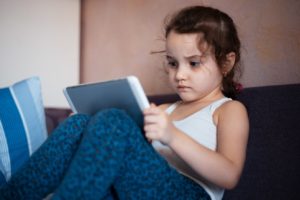We had emphasised on the need to control your child’s screen time when the circuit breaker started in April 2020. https://wp.me/p4Oy1Q-1d9 Here’s another article from Review of Myopia Management on why you should control your child’s screen time .
April 6, 2020
By Joshua Foreman, PhD
Mohamed Dirani, PhD, MBA, GAICD
Thanveer Ali, BSocSci (Hons)

The COVID-19 pandemic continues to create the most significant disruptions to global society seen in generations, and humanity is battling not only to come to terms with the virulence of the coronavirus itself but also the increasingly restrictive and draconian lockdowns and shelter-in-place orders that have frozen life as we knew it in its tracks.
As schools close parents worldwide are confronted with having their children at home with them 24 hours a day and are struggling to keep their children occupied. Many are turning to mobile devices to occupy their children’s attention. Findings from our online survey support this, with the average daily screen time among Singaporean adults increasing from 6.6 hours before the emergence of coronavirus to 7.8 hours in just a few weeks.1 An analysis of screen time among children is sure to produce similar findings. While this excess screen time may help to stave off boredom during one epidemic, it is likely to be contributing to the exacerbation of another: myopia.
Near-work was known to be one of the most important risk factors for the onset and progression of myopia before the smart device revolution,2 with behaviors that include more time spent reading, poor reading posture, and a closer viewing distance being particularly problematic.3,4 Compounding the risk is that more time on near-work has been associated with less time outdoors, which is another well-established factor in myopia’s etiology.5 Screen-based activities constitute a new form of near-work, and children who use devices tend to do so indoors for long uninterrupted periods with poor posture and at viewing distances closer than conventional books.6,7 It is clear why the theory that screens are contributing to the recent upsurge in the myopia epidemic has gained traction. Indeed, the evidence base supporting this link has grown impressively in a very short time.8-10
Apart from myopia, excessive screen time also increases the risk of other adverse health outcomes, including digital eye strain,11,12 mental illness,13-15 musculoskeletal problems,16,17 diabetes,18 heart disease, and cancer.19 The COVID-19 pandemic is not likely to abate soon, and there is a clear imperative to find ways to protect children from boredom as well as from the detrimental effects caused by screens. Eye care professionals can give their patients the following advice to manage their child’s screen time and may benefit from implementing these guidelines within their own families.
- Take regular breaks from screens
Screens can be addictive20 and it is easy to lose track of long uninterrupted periods of absorption in our devices. It is essential to take regular breaks between periods of screen exposure. A break of at least 15 minutes should be taken after two hours of device use at a minimum.21
- Maintain a healthy face-to-screen distance
Ensure adequate face-to-screen distance when you or your child use devices. Distances of 60cm for computer screens22 and 30cm for smart devices such as phones or tablets are recommended.7
- At-home alternatives to outdoor activities and screen time
Your home may feel deceptively void of fun activities to do with your children, and as such, it is natural to feel at a loss these days when it comes to occupying their time, especially in parts of the world where going outside is no longer an option. Creating a routine for your child is a useful way to ensure that their time is used productively and with purpose. This routine should include blocks of screen-free playtime. If independent play is a struggle for your child, set aside some time to engage in play with him or her. This can include storytelling, having a workout session together and even doing household chores together.
Whatever you choose to do with your child, remember to use these moments as golden opportunities to spend some quality time bonding. Your environment is filled with objects that are constantly competing for your attention, and this includes the inquisitive questions or smiles of your child as well as the continually vibrating phone in your hand. Sadly, the phone usually wins the war for your attention, and when this happens, you lose an opportunity to connect with your child that you will never get back. Being forced to stay indoors with your child may be just the excuse you need to get creative and embrace quality time with them. This may be the best chance you ever get.
Everyone wants what is best for their children. While Netflix Nanny is a tempting substitute for your attentive parenting, the long-term well being of your children needs your attention now. Granted, it is hard to focus on myopia and the array of other health concerns arising from device dependency when the immediate threat of infection is so salient and ever-present. Still, if you help your children to maintain a balanced and safe relationship with their devices now when they are still able to see the world that emerges through the clearing smoke at the end of this strange period in human history, they will surely thank you.
Joshua Foreman, PhD, is the head of research at Plano Pte Ltd, a technology company that develops solutions to manage excessive smart device use and myopia among children worldwide. He is also a research fellow at the Department of Ophthalmology at the University of Melbourne and a Visiting Scholar at the School of Global Public Health at New York University, and he holds honorary positions at the Centre for Eye Research Australia and the School of Public Health at the University of California, Berkeley.
Mohamed Dirani, PhD, MBA, GCAID, is the founding managing director of Plano Pte Ltd and an adjunct associate professor at the Duke-NUS Medical School. He is also an adjunct principal investigator at the Singapore Eye Research Institute and an Honorary Fellow at the Centre for Eye Research Australia.
Thanveer Ali, BSocSc (Hons), Economics, is the head of communications of Plano Pte Ltd.
References
- Plano. Plano Time Machine. 2020. https://timemachine.plano.co/.
- Saw SM, Hong CY, Chia KS, Stone RA, Tan D. Near-work and myopia in young children. Lancet 2001; 357(9253): 390.
- Lyu Y, Zhang H, Gong Y, et al. Prevalence of and factors associated with myopia in primary school students in the Chaoyang District of Beijing, China. Jpn J Ophthalmol 2015; 59(6): 421-9.
- You QS, Wu LJ, Duan JL, et al. Factors associated with myopia in school children in China: the Beijing childhood eye study. PLoS One 2012; 7(12): e52668.
- Sherwin JC, Reacher MH, Keogh RH, Khawaja AP, Mackey DA, Foster PJ. The association between time spent outdoors and myopia in children and adolescents: a systematic review and meta-analysis. Ophthalmology 2012; 119(10): 2141-51.
- Cuellar JM, Lanman TH. “Text neck”: an epidemic of the modern era of cell phones? Spine J 2017; 17(6): 901-2.
- Bababekova Y, Rosenfield M, Hue JE, Huang RR. Font size and viewing distance of handheld smart phones. Optom Vis Sci 2011; 88(7): 795-7.
- Saxena R, Vashist P, Tandon R, et al. Prevalence of myopia and its risk factors in urban school children in Delhi: the North India Myopia Study (NIM Study). PLoS One 2015; 10(2): e0117349.
- Singh NK, James RM, Yadav A, Kumar R, Asthana S, Labani S. Prevalence of Myopia and Associated Risk Factors in Schoolchildren in North India. Optom Vis Sci 2019; 96(3): 200-5.
- Hinterlong JE, Holton VL, Chiang CC, Tsai CY, Liou YM. Association of multimedia teaching with myopia: A national study of school children. J Adv Nurs 2019; 75(12): 3643-53.
- Moon JH, Lee MY, Moon NJ. Association between video display terminal use and dry eye disease in school children. J Pediatr Ophthalmol Strabismus 2014; 51(2): 87-92.
- Moon JH, Kim KW, Moon NJ. Smartphone use is a risk factor for pediatric dry eye disease according to region and age: a case control study. BMC ophthalmology 2016; 16(1): 188-.
- Sampasa-Kanyinga H, Lewis RF. Frequent Use of Social Networking Sites Is Associated with Poor Psychological Functioning Among Children and Adolescents. Cyberpsychol Behav Soc Netw 2015; 18(7): 380-5.
- Liu M, Wu L, Yao S. Dose-response association of screen time-based sedentary behaviour in children and adolescents and depression: a meta-analysis of observational studies. Br J Sports Med 2016; 50(20): 1252-8.
- Park J, Kim J, Kim J, et al. The effects of heavy smartphone use on the cervical angle, pain threshold of neck muscles and depression; 2015.
- Rosenfield M. Computer vision syndrome (a.k.a. digital eye strain); 2016.
- Sheppard AL, Wolffsohn JS. Digital eye strain: prevalence, measurement and amelioration. BMJ Open Ophthalmology 2018; 3(1): e000146.
- Nightingale CM, Rudnicka AR, Donin AS, et al. Screen time is associated with adiposity and insulin resistance in children. Arch Dis Child 2017; 102(7): 612-6.
- Celis-Morales CA, Lyall DM, Steell L, et al. Associations of discretionary screen time with mortality, cardiovascular disease and cancer are attenuated by strength, fitness and physical activity: findings from the UK Biobank study. BMC Med 2018; 16(1): 77.
- Yuan K, Qin W, Wang G, et al. Microstructure abnormalities in adolescents with internet addiction disorder. PLoS One 2011; 6(6): e20708.
- American Optometric Association. Computer Vision Syndrome. https://www.aoa.org/patients-and-public/caring-for-your-vision/protecting-your-vision/computer-vision-syndrome (accessed April 5th 2020.
- Rosenfield M. Computer vision syndrome: a review of ocular causes and potential treatments. Ophthalmic Physiol Opt 2011; 31(5): 502-15.
The above article is taken from Review of Optometric management.

